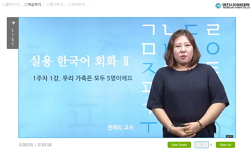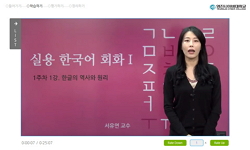배경 및 목적: 한국어 독화소 체계 분석에 관한 기존의 연구들은 한정된 음소들을 조합하여 이루어짐으로써 일상회화체의 다양한 특성들을 반영하지 못한 점이 있다. 이에 본 연구는 일상회...
http://chineseinput.net/에서 pinyin(병음)방식으로 중국어를 변환할 수 있습니다.
변환된 중국어를 복사하여 사용하시면 됩니다.
- 中文 을 입력하시려면 zhongwen을 입력하시고 space를누르시면됩니다.
- 北京 을 입력하시려면 beijing을 입력하시고 space를 누르시면 됩니다.
https://www.riss.kr/link?id=A103524030
- 저자
- 발행기관
- 학술지명
- 권호사항
-
발행연도
2017
-
작성언어
-
- 주제어
-
KDC
370
-
등재정보
KCI등재,SCOPUS,ESCI
-
자료형태
학술저널
- 발행기관 URL
-
수록면
615-628(14쪽)
-
KCI 피인용횟수
1
- DOI식별코드
- 제공처
-
0
상세조회 -
0
다운로드
부가정보
국문 초록 (Abstract)
배경 및 목적: 한국어 독화소 체계 분석에 관한 기존의 연구들은 한정된 음소들을 조합하여 이루어짐으로써 일상회화체의 다양한 특성들을 반영하지 못한 점이 있다. 이에 본 연구는 일상회화체 내 음소 출현율을 반영한 한국표준 단음절어표 일반용(Korean Standard Monosyllabic Word List for Adults, KS-MWL-A)을 사용하여 독화검사를 실시하고, 한국어의 독화소 체계를 초성ㆍ중성ㆍ종성별로 분석하는 데 목적이 있다. 방법: 남녀 화자 2명이 단음절어표를 자연스럽게 발화하는 모습을 녹화하여 성인 32명을 대상으로 음성 없이 독화검사를 실시하고, 단어 정반응률, 음소 정반응률, 반응음소 출현율을 구하였고, 음소 정반응률을 비교하기 위해 일원분산분석을 실시하였다. 초성ㆍ중성ㆍ종성 혼동 행렬을 통해 반응음소군을 확인하고, 누적 정반응률 60%를 기준으로 독화소군을 결정하였다. 결과: 연구결과, 단어 정반응률은 13.00%였으며, 음소 정반응률은 초성 19.04%, 중성 48.26%, 종성 44.77%로 초성이 중성, 종성보다 유의미하게 낮았다. 각 음소별 반응음소군을 통해서 독화소군을 초성 /ㄱ, ㄲ, ㅋ, ㅎ, ([ ])/, /ㄴ, ㄷ, ㄸ, ㅌ, (ㅅ, [ ])/, /ㅁ, ㅂ, ㅃ, ㅍ/, /ㅅ, ㅆ, ㅈ, ㅊ/ 4개, 중성모음 /ㅣ, ㅡ, ㅢ/, /ㅟ/, /ㅗ, ㅛ/, /ㅏ, ㅑ/, /ㅜ, ㅠ/, /ㅓ, ㅕ/, /ㅘ, ㅚ, (ㅙ)/, /ㅖ, ㅐ, ㅔ/ 8개, 종성자음 [ ], /ㄱ, ㅇ/, /ㄴ, ㄷ/, /ㄹ/, /ㅁ, ㅂ/ 5개로 분류하였다. 논의 및 결론: 한국어 초성자음과 종성자음의 독화소 체계에 미치는 중성모음의 영향력을 확인하였으며, 또한 종성의 유무에 대한 민감성이 종성 독화소 체계에 영향을 미치는 것으로 나타났다.
다국어 초록 (Multilingual Abstract)
Objectives: The purpose of this study was to investigate the speechreading abilities of the Korean population and verify the Korean viseme system by utilizing the Korean Standard Monosyllabic Word List for Adults (KS-MWL-A), a list of words selected i...
Objectives: The purpose of this study was to investigate the speechreading abilities of the Korean population and verify the Korean viseme system by utilizing the Korean Standard Monosyllabic Word List for Adults (KS-MWL-A), a list of words selected in consideration of phonemic balance and frequency of everyday use. Methods: KS-MWL-A words spoken by both male and female speakers were filmed. The speechreading test with no auditory cues was performed on 32 subjects and the percent correct scores of words and phonemes were identified and analyzed using ANOVA. Three positions of phonemes, initial, medial and final, were classified according to a confusion matrix to determine the Korean viseme groups based on a criterion of a 60% correct response. Results: The results showed that the percent correct score of words was 13.00%. The percent correct scores of phonemes of initial, medial, and final positions were 19.04%, 48.26%, and 44.77%, respectively. The Korean visemes were classified as initial phonemes [/k, kh, k’, h, [ ]/, /n, d, t’, th, (s), [ ]/, /m, p, ph, p’/, /s, s’, ʨ, ʨh/], medial phonemes [/i, ɯ, ɯi/, /wi/, /o, jo/, /a, ja/, /u, ju/, /ʌ, jʌ/, /wa, Ø, (wε)/, /jε, æ, e/] and final phonemes [/[ ], k, ŋ/, /n, d/, /l/, /m, b/]. Conclusion: It was revealed that vowels affect both the initial and final position of consonants in the Korean viseme system. Furthermore, the sensitivity to the presence of the final consonant seemed to have the capability to affect the final consonant of the viseme system.
목차 (Table of Contents)
- Abstract
- 연구방법
- 연구결과
- 논의 및 결론
- REFERENCES
- Abstract
- 연구방법
- 연구결과
- 논의 및 결론
- REFERENCES
- 국문초록
- 참고문헌
참고문헌 (Reference)
1 박혜진, "학령기 인공와우 착용 아동의 어휘력과 말지각 상관성" 한국언어청각임상학회 21 (21): 488-501, 2016
2 변성완, "전국의 수련 병원에서 사용하고 있는 한국어 단음절어음표의실태 및 어음 빈도 분석" 대한이비인후과학회 48 (48): 1086-1090, 2005
3 박무균, "어음청력검사 어음표의 주파수별 음향학적 특성에 관한 연구" 대한이비인후과학회 50 (50): 480-485, 2007
4 임예람, "스마트폰을 이용한 원격 독화 중재가 청년층 청각장애인의 독화 능력에 미치는 영향" 특수교육연구소 15 (15): 125-154, 2016
5 김종현, "국어표준화 독화기능 검사 개발을 위한 연구(1)" 한국언어치료학회 14 (14): 23-41, 2005
6 김종현, "국어 말읽기 기능 검사의 타당성 연구" 한국언어치료학회 25 (25): 57-66, 2016
7 Wozniak, V. D., "Visual vowel and diphthong perception from two horizontal viewing angles" 22 : 354-365, 1979
8 Lesner, S. A., "Visual vowel and diphthong perception across speakers" 14 : 252-258, 1981
9 Holden, E. J., "Visual speech recognition using cepstral images" 331-336, 2000
10 Lidestam, B., "Visual phonemic ambiguity and speechreading" 49 : 835-847, 2006
1 박혜진, "학령기 인공와우 착용 아동의 어휘력과 말지각 상관성" 한국언어청각임상학회 21 (21): 488-501, 2016
2 변성완, "전국의 수련 병원에서 사용하고 있는 한국어 단음절어음표의실태 및 어음 빈도 분석" 대한이비인후과학회 48 (48): 1086-1090, 2005
3 박무균, "어음청력검사 어음표의 주파수별 음향학적 특성에 관한 연구" 대한이비인후과학회 50 (50): 480-485, 2007
4 임예람, "스마트폰을 이용한 원격 독화 중재가 청년층 청각장애인의 독화 능력에 미치는 영향" 특수교육연구소 15 (15): 125-154, 2016
5 김종현, "국어표준화 독화기능 검사 개발을 위한 연구(1)" 한국언어치료학회 14 (14): 23-41, 2005
6 김종현, "국어 말읽기 기능 검사의 타당성 연구" 한국언어치료학회 25 (25): 57-66, 2016
7 Wozniak, V. D., "Visual vowel and diphthong perception from two horizontal viewing angles" 22 : 354-365, 1979
8 Lesner, S. A., "Visual vowel and diphthong perception across speakers" 14 : 252-258, 1981
9 Holden, E. J., "Visual speech recognition using cepstral images" 331-336, 2000
10 Lidestam, B., "Visual phonemic ambiguity and speechreading" 49 : 835-847, 2006
11 Erber, N. P., "Visual perception of speech by deaf children : recent developments and continuing needs" 39 : 178-185, 1974
12 Binnie, C. A., "Visual intelligibility of consonants : a lipreading screening test with implications for aural rehabilitation" 41 : 530-539, 1976
13 O’Neill, J. J., "Visual communication for the hard of hearing" Prentice-Hall 1981
14 Owens, E., "Visemes observed by hearing-impaired and normal-hearing adult viewers" 28 : 381-393, 1985
15 Leaner, S. A., "Training influences on visual consonant and sentence recognition" 8 : 283-287, 1987
16 Jackson, P. L., "The theoretical minimal unit for visual speech perception : visemes and coarticulation" 90 : 99-115, 1988
17 Kuk, M. K., "The effect of the lipreading programs on hearing-impaired children’s lipreading and voice" 5 : 99-122, 1997
18 Kuk, M. K., "The effect of lipreading program on a hearing-impaired adult’s lipreading" 21 : 107-118, 1998
19 Lee, J. H., "Standard pronunciation and real pronunciation of Korean" Acanet 2012
20 Jeffers, J., "Speechreading(lipreading)" Charles C. Thomas 1971
21 Mohammed, T., "Speechreading skill and visual movement sensitivity are related in deaf speechreaders" 34 : 205-216, 2005
22 Woll, B., "Speechreading revisited" 14 : 16-21, 2012
23 Auer, E. T., "Speechreading and the structure of the lexicon : computationally modeling the effects of reduced phonetic distinctiveness on lexical uniqueness" 102 : 3704-3710, 1997
24 Bernstein, L. E., "Speech perception without hearing" 62 : 233-252, 2000
25 Walden, B. E., "Some effects of training on speech recognition by hearing-impaired adults" 24 : 207-216, 1981
26 Montgomery, A. A., "Physical characteristics of the lips underlying vowel lipreading performance" 73 : 2134-2144, 1983
27 De Filippo, C. L., "New reflections on speechreading" 90 : 1-313, 1988
28 Hiki, S., "Negative effect of homophones on speechreading in Japanese" 1997
29 Cohen, M. M., "Models and techniques in computer animation" Springer Japan 139-156, 1993
30 Lee, K. S., "Language instruction and therapy method for deaf childhood" Daegu University 2006
31 Burnham, D., "Hearing eye II : the psychology of speechreading and auditory-visual speech East" Psychology Press 2013
32 Summerfield, Q., "Hearing by eye: the psychology of lip-reading" Lawrence Erlbaum 3-51, 1987
33 Dodd, B., "Hearing by eye : the psychology of lip-reading" Lawrence Erlbaum Associates 1987
34 Byun, S. W., "Frequencies of Korean phonemes and reliability of Korean phonetically balanced word lists" 44 : 485-489, 2001
35 Tye-Murray, N., "Foundations of aural rehabilitation : children, adults, and their family members. Stamford" Nelson Education 2014
36 Walden, B. E., "Effects of training on the visual recognition of consonants" 20 : 130-145, 1977
37 Auer, E. T., "Effects of phonetic variation and the structure of the lexicon on the uniqueness of words" 21-24, 1997
38 Montgomery, A. A., "Effects of consonantal context on vowel lipreading" 30 : 50-59, 1987
39 Kim, Y. W., "Effectiveness of speechreading cues for hearing impaired children" 57 : 69-108, 1993
40 Kricos, P. B., "Differences in visual intelligibility across talkers" 84 (84): 219-225, 1982
41 Kim, J. S., "Development of Korean Standard Monosyllabic Word Lists for Adults(KS-MWL-A)" 4 : 126-140, 2008
42 Fisher, C., "Confusions among visually perceived consonants" 11 : 796-804, 1968
43 Lee, S. C., "Comparison of speechreading abilities of adults with normal hearing and with hearing impairment" Nazarene University 2010
44 Benguerel, A. P., "Coarticulation effects in lipreading" 25 : 600-607, 1982
45 Grant, K. W., "Auditory-visual speech recognition by hearing impaired subjects : consonant recognition, sentence recognition, and auditory-visual integration" 103 : 2677-2690, 1998
46 Lamoré, P. J., "Auditory, visual and audiovisual perception of segmental speech features by severely hearing-impaired children" 37 : 396-419, 1998
47 Watson, C. S., "Auditory and visual speech perception: confirmation of a modality-independent source of individual differences in speech recognition" 100 : 1153-1162, 1996
48 Chen, T., "Audiovisual speech processing" 18 : 9-21, 2001
49 Chen, T., "Audio-visual integration in multimodal communication" 86 : 837-852, 1998
50 Kim, J. H., "An analysis of the factors constituting speechreading skill" Daegu University 1992
51 Park, S. L., "A study on the frequencies of consonants in adult conversational Korean" Ewha Womans University 1999
52 Kim, Y. W., "A study of the minimal lip-reading units in Korean phonemes" 14 : 55-72, 1997
53 Lee, K. S., "A review on primary factors of speechreading skill" 12 : 23-49, 1991
동일학술지(권/호) 다른 논문
-
Longitudinal Study of Vocal Development in 9- to 18-Month-Old Children Acquiring Korean
- 한국언어청각임상학회
- 하승희(Seunghee Ha)
- 2017
- KCI등재,SCOPUS,ESCI
-
Anaphor Resolution in Children with Poor Reading Comprehension
- 한국언어청각임상학회
- 김명수(Myungsoo Kim)
- 2017
- KCI등재,SCOPUS,ESCI
-
Rapid Automatized Naming Performance in Korean-Speaking Children with Dyslexia
- 한국언어청각임상학회
- 강진경(Jin Kyong Kang)
- 2017
- KCI등재,SCOPUS,ESCI
-
A Comparison of Writing Ability between Children with and without ADHD According to Length of Story
- 한국언어청각임상학회
- 고선희(Sunhee Ko)
- 2017
- KCI등재,SCOPUS,ESCI
분석정보
인용정보 인용지수 설명보기
학술지 이력
| 연월일 | 이력구분 | 이력상세 | 등재구분 |
|---|---|---|---|
| 2018 | 평가예정 | 계속평가 신청대상(등재유지) | |
| 2015-01-01 | 평가 | 등재학술지 유지(등재유지) |  |
| 2013-03-29 | 학술지명변경 | 한글명 : Communication Sciences and Disorders</br>외국어명 : Communication Sciences and Disorders |  |
| 2012-12-18 | 학술지명변경 | 한글명 : 언어청각장애연구</br>외국어명 : Communication Sciences and Disorders |  |
| 2011-01-01 | 평가 | 등재학술지 유지(등재유지) |  |
| 2009-01-01 | 평가 | 등재학술지 유지(등재유지) |  |
| 2007-06-25 | 학술지명변경 | 한글명 : 언어청각장애연구</br>외국어명 : Korean Journal of Communication Disorders |  |
| 2007-01-01 | 평가 | 등재학술지 유지(등재유지) |  |
| 2006-09-13 | 학술지명변경 | 한글명 : 언어청각장애연구</br>외국어명 : Korean Journal of Communication Disorders |  |
| 2005-10-14 | 학술지명변경 | 한글명 : 언어청각장애연구</br>외국어명 : Korean Journal of Communication Disorders |  |
| 2004-01-01 | 평가 | 등재학술지 선정(등재후보2차) |  |
| 2003-01-01 | 평가 | 등재후보 1차 PASS(등재후보1차) |  |
| 2001-07-01 | 평가 | 등재후보학술지 선정(신규평가) |  |
학술지 인용정보
| 기준연도 | WOS-KCI 통합IF(2년) | KCIF(2년) | KCIF(3년) |
|---|---|---|---|
| 2016 | 1.13 | 1.13 | 1.17 |
| KCIF(4년) | KCIF(5년) | 중심성지수(3년) | 즉시성지수 |
| 1.21 | 1.18 | 1.626 | 0.33 |





 ScienceON
ScienceON 스콜라
스콜라






